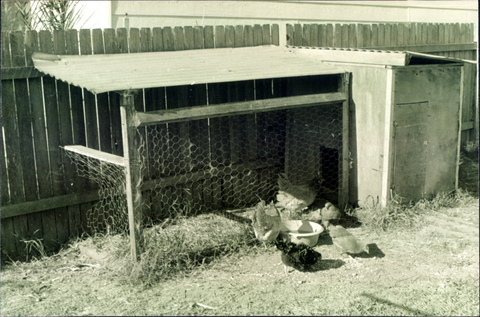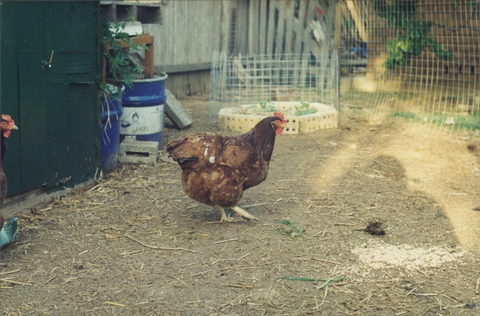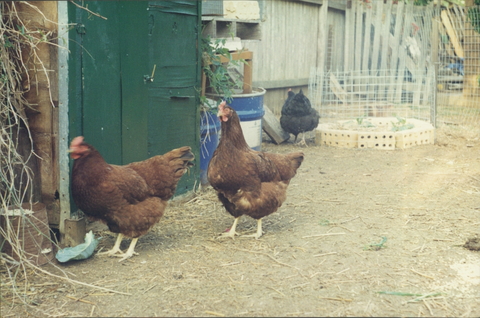
We first got chooks back in the late 1980s, I had wanted to give them a go for a while but the catalyst was our youngest daughter having food issues, particularly with colours and flavours. This caused us to rethink our diet and since anything but cage eggs were difficult to come across in those days, we started looking into keeping our own. I had been to a conference in Melbourne and met up with a guy from BASF, he showed me a colour card and explained one of his duties was to go and see egg producers. It seems that the cage system was so rough on the chooks, their egg yolks turned out white, so he sold them dye to put in their feed, the more dye, the deeper yellow the yolks were. The colour card helped you work out how much dye to put in to get the shade of yellow you wanted. We haven’t bought caged eggs since.
Our first chooks were bantams, about half a dozen of them, which I had bought because I was under the impression that while full sized chooks were livestock, bantams were regarded as ‘caged birds’ by officialdom and so acceptable in the back yard. This turned out to not be the case but it was what I believed at the time. I had been doing some work with a glasswool insulation manufacturer and they got their glass beads (which they melted to make the insulation) in 1200mm plywood cubes which they would dump. They kindly dropped 3 off at our place, one for the chooks and two for a cubby for the kids.

To make it habitable for chooks I cut a small door in the front of the chook cube (but still big enough for me to climb into), a chook pop hole in the side and put up a shelf as a laying platform and a length of broom handle as a roost. To make it more weather resistant I built a corrugated iron skillion roof and then built a two metre by one metre run outside the shed part. The run was obviously too small and didn’t last long, I ran some chook wire from the back fence, along past the chook shed and around onto the side fence, giving the chooks a run of around 25m2 instead of 2m2. Mind you, the guy we bought them off was over near Sutherland and had what looked like a hundred chooks in small cages lining the inside of a garden shed. I think the chooks were just glad to get out!
They were quite productive for us, but they did not live forever and when they started to pass we looked around for some replacements, full size this time. We got some spent layers from one of the local egg farms. Commercially, once the chooks have laid for a year they are replaced because production drops, and you can occasionally pick some up cheaply as we did. They had never seen what the outside world looked like and I remember placing them in the chook shed and watching as they stuck their heads out and looked very distrustfully at the grass, probably thinking ‘what on earth is that green crap???’. Yet within a few hours they were out pecking and scratching with the others, exhibiting all that wonderful chookie behaviour. They were not only cheaper but we had the built-in satisfaction of rescuing them! The only real issue was that they were beak trimmed (all commercial layers are) and this did interfere with their ability to forage a bit.

I wound up fencing the veggie patch to keep them and out and then letting them out to free range in the afternoon, very relaxing for them and for us watching them. The chook fencing around the chook pen and around the veggies was only a metre tall so a chook could in theory fly over them, thus I had to trim one wing of any and all new chooks to keep them in. The interesting thing was that once the wing had been trimmed they got used to the idea that they couldn’t fly, even once the feathers grew back at then next moult and they didn’t even try.
We kept that process going for over 10 years and while it worked well in terms of egg production it did have some significant downsides, one I didn’t discover until we moved on to the process we use now. Those downsides were –
- Every couple of months or so I would have to climb inside the chooks shed and remove all the chook poop and distribute it around the veggie patches. This was NOT my favourite job!
- We were feeding half the local bird population. I didn’t realise until we enclosed our chook operation and the usage of chook feed dropped by about half!
- While these wild birds loved the cage food, they also left my chooks a gift that keeps on giving in the form of mites. A short conversation with Mr Sulphur Powder and the mites mysteriously disappeared.
Our Chook Journey Part 2: Evolution of a Tractor
Our Chook Journey Part 3: The Retirement Village and Other Things



